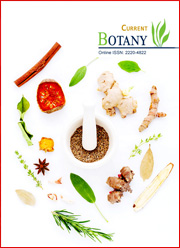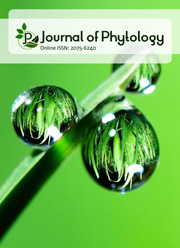Phytochemical evaluation and in vitro antioxidant potential of Cycas circinalis L.
DOI:
https://doi.org/10.25081/cb.2025.v16.9123Keywords:
Cycas circinalis L., Phytochemicals, HPTLC, Antioxidants, In vitroAbstract
Cycas circinalis L., a gymnosperm, is traditionally used by tribal people for various medicinal and culinary purposes. This study investigates the phytoconstituents and antioxidant potential of the leaves, bark, and male cone of C. circinalis. Qualitative screening and quantitative analysis were conducted, followed by analysis of antioxidant potential using in vitro assays. High-performance thin-layer chromatography (HPTLC) analysis of phenols and flavonoids was carried out to identify active constituents. Various phytoconstituents, including alkaloids, phenols, flavonoids, glycosides, quinones, and sterols, were identified in different extracts. The ethanolic extract of the leaves exhibited the highest total phenolic content (8.169 mg GAE/g), while the male cones showed the highest flavonoid content (2.825 mg QE/g). The bark demonstrated significant radical scavenging activity, particularly in ABTS (IC50 59.44 μg/mL) and DPPH (IC50 358.3 μg/mL) assays. In contrast, the leaves exhibited moderate activity across all assays, and the male cones showed relatively lower antioxidant activity, except in the total antioxidant capacity assay (19.25 mg AAE/g). HPTLC analysis detected gallic acid in the bark, along with several unidentified bands. This study is the first to report presence of gallic acid in the extract of bark of C. circinalis. Given the plant’s traditional use in treating swellings, wounds, and ulcers, along with the presence of diverse secondary metabolites and significant in vitro bioactivity, this study highlights the potential of C. circinalis as a natural antioxidant with promising applications in wound treatment.
Downloads
References
Afifi, N., Moawad, A., Hassan, M., El Amir, D., Elwekeel, A., & Amin, E. (2021). Phytochemical content and biological activity of the genus Cycas, Family Cycadaceae: A review. Pharmaceutical Sciences Asia, 48(4), 300-319. https://doi.org/10.29090/psa.2021.04.20.174
Ali, S. A., Sule, I. M., Ilyas, M., Haruna, A. K., Abdulraheem, O. R., & Sikira, A. S. (2011). Ethnopharmacological activities of the leaves of Cycas circinalis (Cycadaceae). Research Journal of Pharmaceutical, Biological and Chemical Sciences, 2(1), 616-628.
Almeida, S. M., & Almeida, M. R. (2010). Hand book of diseases and their herbal remedies in Maharashtra. (Vol. 2). Mumbai, India: Orient Press Ltd.
Ambasta, S. P. (1992). The Useful Plants of India: National Institute of Science Communication. New Delhi, India: Council of Scientific & Industrial Research.
Arshad, M., Chaudhary, A. R., Mumtaz, M. W., Raza, S. A., Ahmad, M., Mukhtar, H., & Bashir, R. (2021). Polyphenol fingerprinting and hypoglycemic attributes of optimized Cycas circinalis leaf extracts. Journal of the Science of Food and Agriculture, 101(4), 1530-1537. https://doi.org/10.1002/jsfa.10771
Badhani, B., Sharma, N., & Kakkar, R. (2015). Gallic acid: A versatile antioxidant with promising therapeutic and industrial applications. RSC Advances, 5(35), 27540-27557. https://doi.org/10.1039/C5RA01911G
Balunas, M. J., & Kinghorn, A. D. (2005). Drug discovery from medicinal plants. Life Sciences, 78(5), 431-441. https://doi.org/10.1016/j.lfs.2005.09.012
Bissa, S., & Bohra, A. (2008). Antibacterial potential of three naked-seeded (Gymnosperm) plants. Indian Journal of Natural Products and Resources, 7(5), 420-425.
Bourgaud, F., Gravot, A., Milesi, S., & Gontier, E. (2001). Production of plant secondary metabolites: A historical perspective. Plant Science, 161(5), 839-851. https://doi.org/10.1016/S0168-9452(01)00490-3
Chang, C.-C., Yang, M.-H., Wen, H.-M., & Chern, J.-C. (2020). Estimation of total flavonoid content in propolis by two complementary colometric methods. Journal of Food and Drug Analysis, 10(3), 3. https://doi.org/10.38212/2224-6614.2748
Chopra, R. N., & Nayar, S. L. (1956). Glossary of Indian medicinal plants. New Delhi, India: Council of Scientific and Industrial Research.
Dahanukar, S. A., Kulkarni, R. A., & Rege, N. N. (2000). Pharmacology of medicinal plants and natural products. Indian Journal of Pharmacology, 32(4), 81-118.
Das, B., Paul, T., Apte, K. G., Chauhan, R., & Saxena, R. C. (2013). Evaluation of antioxidant potential & quantification of polyphenols of Diplazium esculentum Retz. With emphasis on its HPTLC chromatography. Journal of Pharmacy Research, 6(1), 93-100. https://doi.org/10.1016/j.jopr.2012.11.020
Donaldson, J. (2003). Cycads: Status survey and conservation action plan. Gland, Switzerland: IUCN–the World Conservation Union. Retrieved from https://portals.iucn.org/library/sites/library/files/documents/2003-010.pdf
El-Seadawy, H. M., Abo El-Seoud, K. A., El-Aasr, M., & Ragab, A. E. (2023). Cycadaceae: An Important Source for Biflavonoids and Various Pharmacological Effects of Different Cycas Species. Journal of Advanced Medical and Pharmaceutical Research, 4(2), 35-41. https://doi.org/10.21608/jampr.2023.202016.1051
Farnsworth, N. R. (1966). Biological and Phytochemical Screening of Plants. Journal of Pharmaceutical Sciences, 55(3), 225-276. https://doi.org/10.1002/jps.2600550302
Ganie, S. H., Upadhyay, P., Das, S., & Sharma, M. P. (2015). Authentication of medicinal plants by DNA markers. Plant Gene, 4, 83-99. https://doi.org/10.1016/j.plgene.2015.10.002
Gocan, S., & Cimpan, G. (2004). Review of the Analysis of Medicinal Plants by TLC: Modern Approaches. Journal of Liquid Chromatography & Related Technologies, 27(7-9), 1377-1411. https://doi.org/10.1081/JLC-120030607
Gohil, K. J., Patel, J. A., & Gajjar, A. K. (2010). Pharmacological Review on Centella asiatica: A Potential Herbal Cure-all. Indian Journal of Pharmaceutical Sciences, 72(5), 546-556. https://doi.org/10.4103/0250-474X.78519
Hill, K. D. (1995). The genus Cycas (Cycadaceae) in the Indian region, with notes on the application and typification of the name Cycas circinalis. Taxon, 44(1), 23-31. https://doi.org/10.2307/1222674
Hollman, P. C. H., & Katan, M. B. (1997). Absorption, metabolism and health effects of dietary flavonoids in man. Biomedicine & Pharmacotherapy, 51(8), 305-310. https://doi.org/10.1016/s0753-3322(97)88045-6
Kumar, B. S., Kumar, J. V., & Selvaraj, R. (2013). Aphrodisiac activity of Cycas circinalis. L and Ionidium suffruticosum. Ging on male wister albino rats. Asian Journal of Pharmaceutical and Clinical Research, 6(3), 215-217.
Mane, S. B., Ambali, M. P., & Doshi, M. A. (2023). Effects of Cycas circinalis and Ionidium suffruticosum on Male Wistar Rats that Have Been Made Sterile by Alcohol. Journal of Coastal Life Medicine, 11, 2703-2711.
Moawad, A., Hetta, M., Zjawiony, J. K., Jacob, M. R., Hifnawy, M., Marais, J. P. J., & Ferreira, D. (2010). Phytochemical Investigation of Cycas circinalis and Cycas revoluta Leaflets: Moderately Active Antibacterial Biflavonoids. Planta Medica, 76(8), 796-802. https://doi.org/10.1055/s-0029-1240743
Mussin, J., & Giusiano, G. (2020). Ethno–Phytopharmacology: Product Validation Process Based on Traditional Knowledge of Medicinal Plants. In P. A. Chong, D. J. Newman & D. A. Steinmacher (Eds.), Agricultural, Forestry and Bioindustry Biotechnology and Biodiscovery (pp. 331-353) Cham, Switzerland: Springer International Publishing. https://doi.org/10.1007/978-3-030-51358-0_17
Oyaizu, M. (1986). Studies on products of browning reaction. Antioxidative activities of products of browning reaction prepared from glucosamine. The Japanese Journal of Nutrition and Dietetics, 44(6), 307-315. https://doi.org/10.5264/eiyogakuzashi.44.307
Patel, A. A., Amin, A. A., Patwari, A. H., & Shah, M. B. (2017). Validated high performance thin layer chromatography method for simultaneous determination of quercetin and gallic acid in Leea indica. Revista Brasileira de Farmacognosia, 27(1), 50-53. https://doi.org/10.1016/j.bjp.2016.05.017
Prasad, M. N. V., Padmalatha, K., Jayaram, K., Raju, N. L., & da Silva, J. A. T. (2007). Medicinal plants from Deccan Ecoregion, India: Traditional knowledge, ethnopharmacology, cultivation, utilization, conservation and biotechnology–opportunities and impediments. Medicinal and Aromatic Plant Science and Biotechnology, 1(2), 155-208.
Prieto, J. M. (2012). Procedure: Preparation of DPPH Radical, and Antioxidant Scavenging Assay. Dr Prieto’s DPPH Microplate Protocol, 1-3.
Prieto, P., Pineda, M., & Aguilar, M. (1999). Spectrophotometric Quantitation of Antioxidant Capacity through the Formation of a Phosphomolybdenum Complex: Specific Application to the Determination of Vitamin E. Analytical Biochemistry, 269(2), 337-341. https://doi.org/10.1006/abio.1999.4019
Re, R., Pellegrini, N., Proteggente, A., Pannala, A., Yang, M., & Rice-Evans, C. (1999). Antioxidant activity applying an improved ABTS radical cation decolorization assay. Free Radical Biology & Medicine, 26(9-10), 1231-1237. https://doi.org/10.1016/s0891-5849(98)00315-3
Sethi, P. (2014). Larvicidal activity of a living fossil! Journal of Entomology and Zoology Studies, 2(6), 246-248.
Shahidi, F., & Ambigaipalan, P. (2015). Phenolics and polyphenolics in foods, beverages and spices: Antioxidant activity and health effects – A review. Journal of Functional Foods, 18, 820-897. https://doi.org/10.1016/j.jff.2015.06.018
Shaikh, J. R., & Patil, M. K. (2020). Qualitative tests for preliminary phytochemical screening: An overview. International Journal of Chemical Studies, 8(2), 603-608. https://doi.org/10.22271/chemi.2020.v8.i2i.8834
Sharma, R. R., Deep, A., & Abdullah, S. T. (2022). Herbal products as skincare therapeutic agents against ultraviolet radiation-induced skin disorders. Journal of Ayurveda and Integrative Medicine, 13(1), 100500. https://doi.org/10.1016/j.jaim.2021.07.016
Singleton, V. L., Orthofer, R., & Lamuela-Raventós, R. M. (1999). Analysis of total phenols and other oxidation substrates and antioxidants by means of folin-ciocalteu reagent. Methods in Enzymology, 299, 152-178. https://doi.org/10.1016/S0076-6879(99)99017-1
Sreejayan, & Rao, M. N. A. (1997). Nitric Oxide Scavenging by Curcuminoids. Journal of Pharmacy and Pharmacology, 49(1), 105-107. https://doi.org/10.1111/j.2042-7158.1997.tb06761.x
Syarifah, A. L., Retnowati, R., & Soebiantoro (2019). Characterization of Secondary Metabolites Profile of Flavonoid from Salam Leaves (Eugenia polyantha) Using TLC and UV Spectrophotometry. Pharmaceutical Sciences and Research, 6(3), 4. https://doi.org/10.7454/psr.v6i3.4219
Whitelaw, A. (1826). Materia Indica. (Vol. 2). London, UK: A. & R. Spottiswoode.
Zimila, H. E., Mandlate, J. S., Artur, E. M., Muiambo, H. F., & Uamusse, A. A. (2021). Vortex-assisted Solid-Liquid Extraction for Rapid Screening of Oil Content in Jatropha Seed: An Alternative to the Modified Soxhlet Method. South African Journal of Chemistry, 75, 1-5.
Published
How to Cite
Issue
Section
Copyright (c) 2025 Zoofishan Kazi, Simran Singh, Vijaya Lobo

This work is licensed under a Creative Commons Attribution-NonCommercial 3.0 Unported License.



 .
.